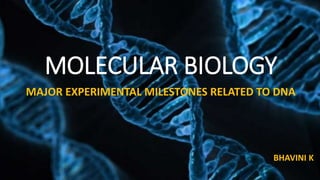
FAMOUS MOLECULAR BIOLOGY EXPERIMENTS
- 1. MOLECULAR BIOLOGY MAJOR EXPERIMENTAL MILESTONES RELATED TO DNA BHAVINI K
- 3. DNA- Basics • DNA = Deoxyribonucleic acid • Occurrence = nucleus (eukaryotic organisms) , in region called nucleoid (prokaryotes). • Certain cell organelles like mitochondria has its own DNA. • The structure of DNA = double helix structure and the two DNA strands are called polynucleotides. • Each strand has a 5′end (with a phosphate group) and a 3′end (with a hydroxyl group). • The strands are antiparallel and complementary to each other. • The two strands are held together by hydrogen bonds. • It has a sugar group and a phosphate group attached to the nitrogen base, linked together by phosphodiester bonds. • There are 4 types of nitrogen bases Adenine (A), Thymine (T), Guanine (G) and Cytosine (C). • A=T and G≡C
- 5. WHY IS DNA IMPORTANT ??? • It contains all the genetic information of an organism (instructions on how the organism needs to develop, live and reproduce) • Directing protein synthesis (central dogma, gene expressions, etc.) • Passed on from generation to generation (from cell to cell) • Directly linked with heredity, inheritance and evolution.
- 6. • Around 3 meters of DNA in each cell ! • Approximately around 10 trillion cells in the body! • Totally, around 10 billion miles of DNA in the entire human body (able to stretch to and fro the sun 61 times!!) • 22 + 1 pairs of chromosomes (total 46 no.) ! • ~ 3 billion base pairs ! • ~ 20,000-25,000 genes in the entire genome ! That’s a lot of information to process !! SO HOW AND WHERE DID IT ALL ABOUT DNA START ?!
- 10. • In 1928, British bacteriologist Frederick Griffith conducted a series of experiments using Streptococcus pneumoniae (also called Diplococcus pneumoniae) bacteria and mice. • Griffith wasn't trying to identify the genetic material, but rather, trying to develop a vaccine against pneumonia. • In his experiments, Griffith used two related strains of bacteria, known as R strain and S strain. • R strain had a rough appearance, and was non-virulent. • S strain had a smoother appearance due to a polysaccharide capsule around it, and was virulent.
- 12. • Griffith concluded that something might have ‘transformed’ the non-virulent R strain. • The R-strain bacteria must have taken up what he called a "transforming principle" from the heat-killed S bacteria, which allowed them to "transform" into smooth-coated bacteria and become virulent. • This was the first step to finding DNA was indeed the genetic material.
- 13. Avery, McCarty, and MacLeod Experiment ~ 1944 ~
- 14. • They took cultures of heat-killed S cells and, progressively purified the transforming principle by washing away, separating out, or enzymatically destroying the other cellular components. • By this method, they were able to obtain small amounts of highly purified transforming principle, which they could then analyse through other tests to determine its identity. • The purified substance gave a negative result in chemical tests known to detect proteins, but a strongly positive result in a chemical test known to detect DNA. • Protein- and RNA-degrading enzymes had little effect on the transforming principle, but enzymes able to degrade DNA eliminated the transforming activity. • These results all pointed to DNA as the likely transforming principle.
- 17. • Hershey and Chase studied bacteriophage- outer structure made of protein and inner core made of DNA. • The phages attached to the surface of a host bacterial cell and injected some substance (either DNA or protein) into the host. • They prepared two different batches of phage. • In each batch, the phage were produced in the presence of a specific radioactive element, which was incorporated into the macromolecules (DNA and protein) that made up the phage. • One sample was produced in the presence of 35 S, and the other with 32 P. • Each batch of phage was used to infect a different culture of bacteria. • After infection had taken place, each culture was whirled in a blender (centrifuge), removing any remaining phage and phage parts from the outside of the bacterial cells. • A pellet and a supernatant were formed.
- 19. • When Hershey and Chase measured radioactivity in the pellet and supernatant from both of their experiments, they found that the pellet was radioactive in case of bacterial cells grown in 32P and the supernatant was radioactive in case of the bacterial cells grown in 35S. • This is because, sulphur is common in proteins and Phosphorus in DNA, hence they proved that DNA is the genetic material.
- 21. • Erwin Chargaff formulated the Chargaff’s rule or the ‘equivalence formula’ of genetics. • He did experiments and based on the paper chromatography and spectrometric conclusions, found that in DNA, the concentration adenine bases is equal to that of thymine and the concentration of guanine is equal to that of cytosine. Total amount of purines = total amount of pyrimidines Or (𝑨 + 𝑻)/(𝑮 + 𝑪) = 𝟏 Or A+T = G+C
- 22. Meselson and Stahl Experiment ~1957~
- 23. • DNA replication is semi-conservative. • Meselson and Stahl conducted their famous experiments on DNA replication using E. coli bacteria as a model system. • They began by growing E. coli in medium, or nutrient broth, containing a "heavy" isotope of nitrogen, 15 N. (generation 0) • Then the culture was shifted to a medium containing light isotope of nitrogen, 14 N (generation 1). • Subsequent generations were left in the same medium.
- 25. THANK YOU